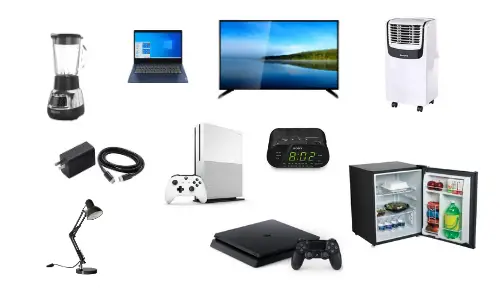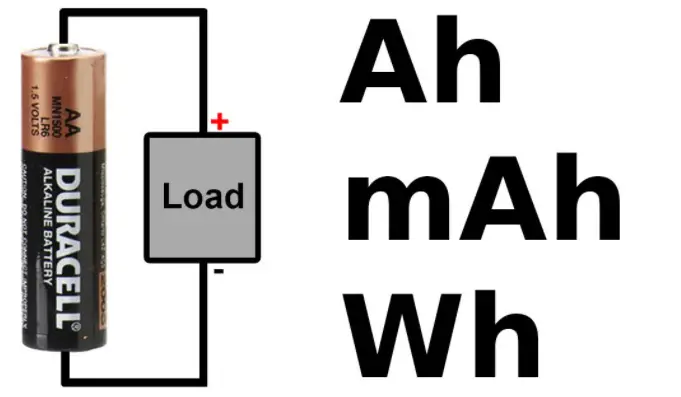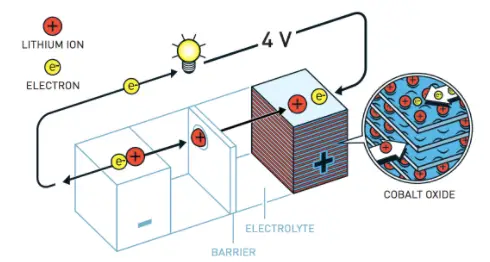
In this quick guide, we’ll talk about some questions that solar RV owners have in mind, along with the biggest question that we think gets asked the most:
What can a 100-watt solar panel run?
There’s a lot of things that solar panels can run, but there are a lot of electronics and appliances that solar panels should never be hooked up to.
New solar panel owners often make mistake thinking their single solar panels can power many things inside of the camp/RV, in fact it's way less.
WHAT CAN A HUNDRED WATT SOLAR PANEL POWER?
New solar panel owners often make mistake thinking their single solar panels can power many things inside of the camp/RV, in fact it's way less.
- A laptop for two hours
- A flat-screen TV for about fifty minutes
- A phone charge for twenty hours!
- A small air conditioning unit for around thirty to forty-five minutes
- A refrigerator for about six minutes
- A clock radio for ten to fifteen hours
- A gaming console for thirty to forty-five minutes
- An LED light bulb for four hours
For solar panels to be the most efficient, they must be directly perpendicular to the sun- a lot of times, this isn’t realistic, but certain states in the United State of America get more “direct sun-time” than other states due to solar irradiance.
For example, someone living in Minnesota or Wisconsin can usually squeeze out 280 watt-hours of energy every day, on average, whereas someone living in Arizona or New Mexico can obtain up to 480 watt-hours of energy, daily, from a single hundred watt solar panel, according to SolarReviews.
There’s many more electronic items to add onto the list, but this is just a basic, generic list of every day, house-hold items. You can try this yourself as well- just take a hundred watt-hours and divide it by however many watts your electronic devices use, and you’ll get an hour figure of how long you can run or charge the device for.
We mentioned going big! A lot of RV owners don’t just stop at one solar panel- imagine, with a class A RV, you could fit twelve of these solar panels on top of your RV. In three hours of direct sunlight, theoretically, you’ve got yourself 3,600 watt-hours to use! That’s enough energy to charge your phone for thirty days, straight.
WATTS VS. WATT-HOURS

A hundred watts may seem like a lot of power (and it is), but when it comes to human beings, we can produce a lot of power with our body as well- according to Stanford University’s research, a human can produce a hundred watts, just by sitting on the couch!
When you sprint, you can easily produce up to 1,500 to 2,000 watts of power, but you don’t want to be running on a treadmill all day, just to charge your phone, right?
Luckily, charging devices such as a phone charger only takes about two to six watts to fully charge a smartphone. So a hundred watt solar panel could easily charge your phone and other things, right? It depends!
The measurement of watts is a lot like instantaneous speed. Imagine a car, zooming down a highway- if we pause on that car, we don’t know if it’s accelerating, decelerating, or if its speed is staying constant, but we do know that the car, at the moment, is travelling at sixty miles per hour.

Watts work the same way- at a given moment, we can figure out that a certain phone charger is giving off five watts of power.
Back to our example, if that same car stays going sixty miles per hour for two hours, we know that in two hours, that car will be 120 miles away from where it originally was.
Watt-hours work in the same way, too- if a phone charger gives off five watts of power for two hours, now you have ten watt-hours that you can use towards your phone. Solar panels are often rated in watts and also watt-hours- it makes it easier to calculate how much energy you truly need to power your appliances and electronics in the RV. Now, we’re talking!
If that hundred watt solar panel is sitting in the sun for three hours, now you have three hundred watt-hours of energy- that is a lot of energy! That can easily charge a smartphone for thirty-six hours straight without any issues, but if we’re talking about power something bigger, we have to go bigger.
WHAT CAN’T I POWER WITH A HUNDRED WATT SOLAR PANEL?
Seriously, that much energy can run a lot of electronic devices, but it cannot run everything. There are some things that you should absolutely avoid to power with solar panels.
Notice how we didn’t add any heat-related items to the list of things you can power with a hundred watt-hour solar panel? That’s because anything that produces heat uses up the most electricity over a given time period.
We’re not saying that you should never power any heat-related devices with a solar panel, but they do drain a lot of juice over time; juice that can be used for other things.
For example, A space heater uses around 3,500 watts of power- if you have twelve solar panels, a total of 3,600 watt-hours of energy, and you use the space heater for just a mere ten minutes to heat the RV up really quickly, you can watch the battery in your solar battery bank go from 100% down to 84% in just under ten minutes.
Other items similar to a space heater include heat-related items such as toasters, heated blankets, microwaves, steam irons, coffee makers, and hair dryers.
WHAT ARE WE LOOKING AT, COST-WISE AND SIZE-WISE?

Hundred-watt solar panels aren’t rare- they’re very common amongst home-owners and RV-owners who are going to switch to green, solar power. A good size for the solar panels is an area that’s four feet in length by two feet in width- The height of the ultraslim solar panels is usually a couple of inches (around two to three inches).
If you know what you’re doing with the cables, the battery, the solar panel, and other electronic accessories, congratulations- you’re looking at about $100 for just a hundred-watt solar panel. Usually, the average person doesn’t know too much about solar power- that’s okay! They make easy, do-it-yourself kits for as little as $300 that includes everything you’ll need to set up your first solar panel.
Maintenance on solar panels isn’t much work- for homeowners, they’ll be required to clean the solar panels weekly, or every other week, but a good rainfall can easily take care of that for you. Rainproof and snow-proof solar panels will be your best friend if you live in an area where rainstorms and windstorms are common.
If you’re an RV owner, they’ll still need to be cleaned, just like the solar panels on top of houses. While not being pointed directly at the sun can drive down the electric efficiencies of the solar panels, the build-up of dust and dirt can also stop the sunlight from hitting the light receptors inside of the solar panels- it may not seem like a lot, but it can add up very quickly.
PAIR IT UP WITH A BATTERY

Almost all of the solar panels that you buy will be needing a battery bank for all of that power to be stored into as well, unless if you bought a solar panel kit- in that case, the kit will include a battery inside of it, but don’t let it stop you from buying a bigger battery bank that will store more power to be used.
Usually, RV owners will buy two batteries, just in case, depending on their budget- the more, the merrier! For a battery, you’ll also need other appliances like inverter chargers, charge controllers, and battery monitors.
Inverter chargers are inverters that convert sunlight power which is usually wild, lingering electricity that doesn’t like to sit still inside of battery banks and want to be used up immediately into usable, DC power which is power that can be stored inside of battery banks to be used later.
Charge controllers are cheap devices that prevent too much power from being used- if you’re going to be using a lot of power at once or connecting a lot of devices up to one battery, you’ll need a charge controller to prevent your solar panels or battery from overheating and being damaged.
Battery monitors are just what they sound like- they’re monitors that you can buy in order to display the amount of battery power left inside of the battery. They’re very cheap and a good-to-have kind of item if you’re a careful planner like me.
If you would like to read more about the battery accessories, be sure to check out our article on them: “How Much Solar Power Do I Need for my RV?”
FREQUENTLY ASKED QUESTIONS
What factors go into how much wattage I’ll get in the solar panels?
The sun is the biggest factor, obviously- the sun will need to hit the solar panels directly in order to get the most out of it. If the day is cloudy or rainy, you’ll still get some power, just not enough to power anything bigger than a lamp or a phone, maybe.
What solar power company do you recommend?
One of the best companies to buy from is Renogy- they have been in the solar business for a while, and they’re constantly innovating to make solar energy harnessing easier.
Another good company is SunPower- they have high-efficiency, portable solar panels which are great for everyday use, for hiking or trekking, for camping, or for a college student like me who enjoys walking around the campus.
How much extra maintenance is required for the solar panels?
They won’t require any more attention than mowing your lawn does- they’ll need to be cleaned or wiped every week or two weeks or so, just like how long you might wait to mow your lawn!
Can I do the installation myself or should I hire someone?
Usually, the kits will come with great details and instructions if you would like to set up the solar panels yourself, but a lot of things can go wrong if it’s your first time setting up a solar panel. If you’re unsure, play it safe and hire a person to come set it up for you- it won’t take too long at all.
Will it damage the roof of my RV or my house?
Usually, solar panels are built to withstand any sort of wind, rain, snow, hail, and sleet. If anything, they’ll provide more protection to the room of your RV or your house. Usually, the solar panels are fifteen lbs in weight, so even if you have twelve solar panels on the top of your class A RV, that’s only an extra 180 lbs that you’re adding on to your roof- in that case, you might want to make sure with the warranty and the company if that is okay- the house’s roof will be absolutely fine with more.
Hopefully, this helped finalize your decision to go green today! If you’re still unsure and have other, unanswered questions, go ahead and read up on some of our other articles that tell you about the different types of solar panels and where to buy them- good luck!
